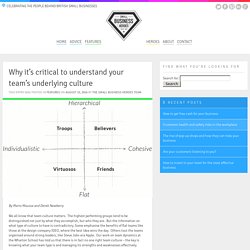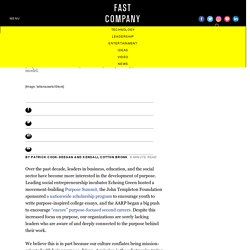

The power of culture: how to hire and attract amazing people. Before Amazon bought Zappos.com for $1.2 billion, the online shoe retailer was already known for two things: exceptional customer service and a vibrant company culture.

As CEO Tony Hsieh once said, “Zappos is a customer service company that just happens to sell shoes.” Zappos empowers its call center staff to make emotional connections and to wow their customers in every interaction. That explains the service-driven reputation. But how do you create a strong, healthy culture — especially as your company grows? Well, Zappos defined 10 core values that guide the whole organization. Why it’s critical to understand your team’s underlying culture. By Mario Moussa and Derek Newberry We all know that team culture matters.

The highest performing groups tend to be distinguished not just by what they accomplish, but who they are. But the information on what type of culture to have is contradictory. Some emphasise the benefits of flat teams like those at the design company IDEO, where the best idea wins the day. Others tout the teams organised around strong leaders, like Steve Jobs-era Apple. Through our research, we have identified four common team cultures, determined by two sets of characteristics: How It Works – Holacracy. Your browser isn't supported. Competing Values Framework and Culture typology. Want A Purpose-Driven Business? Know The Difference Between Mission An. Over the past decade, leaders in business, education, and the social sector have become more interested in the development of purpose.

Leading social entrepreneurship incubator Echoing Green hosted a movement-building Purpose Summit, the John Templeton Foundation sponsored a nationwide scholarship program to encourage youth to write purpose-inspired college essays, and the AARP began a big push to encourage “encore” purpose-focused second careers. Despite this increased focus on purpose, our organizations are sorely lacking leaders who are aware of and deeply connected to the purpose behind their work. The Critically Important Role of Product Teams in Strategy, Innovation & Org Structure. This Is What The Best Teams And Families All Do: 3 Rituals From Research. Leading Change: Why Transformation Efforts Fail. Editor’s Note: Guiding change may be the ultimate test of a leader—no business survives over the long term if it can’t reinvent itself.

But, human nature being what it is, fundamental change is often resisted mightily by the people it most affects: those in the trenches of the business. Thus, leading change is both absolutely essential and incredibly difficult. Perhaps nobody understands the anatomy of organizational change better than retired Harvard Business School professor John P. Your Company’s Culture is Who You Hire, Fire, & Promote. “The actual company values, as opposed to the nice-sounding values, are shown by who gets rewarded, promoted, or let go.” - Netflix Culture: Freedom & Responsibility.

The Problem with Saying “Don’t Bring Me Problems, Bring Me Solutions” Executive Summary It’s time to retire the saying “Don’t bring me problems, bring me solutions.”

Even though advocates of this approach believe it increases empowerment, helps employees manage up, and boosts careers, it’s fraught with challenges. Not every problem has an easy solution, and some require diverse points of view. Requiring solutions can breed a culture of intimidation, and prevent some problems from surfacing until they’re full-blown crises. Many managers demand solutions to avoid a culture of complaining.
A Beginner’s Guide to Org Design – The Ready – Medium. 1.

Agile Squads Definition: A way to organize people with different skill sets and functions around one product or problem. Real Meaning: Teams that are self-contained, autonomous, and intensely focused on the customer. Agile squads have everything they need to accomplish their purpose within the team itself which allows them to work quickly and as autonomously as possible. In the Company of Givers and Takers. Every day, employees make decisions about whether to act like givers or like takers.

When they act like givers, they contribute to others without seeking anything in return. They might offer assistance, share knowledge, or make valuable introductions. When they act like takers, they try to get other people to serve their ends while carefully guarding their own expertise and time. Organizations have a strong interest in fostering giving behavior. A willingness to help others achieve their goals lies at the heart of effective collaboration, innovation, quality improvement, and service excellence. But even as leaders recognize the importance of generous behavior and call for more of it, workers receive mixed messages about the advisability of acting in the interests of others. As employees look around their organizations for models of success, they encounter further reasons to be wary of generosity. But neither finding was that simple. This creates a challenge for managers. Givers, Takers, and the Resilient Mind. My Conversation with Adam Grant.
Are you a giver or a taker?

Have you ever struggled to find work/life balance? The Case for Investing More in People. Executive Summary There is a virtuous cycle between productivity and people: Higher levels of productivity allow society to reinvest in human capital (most obviously, though not exclusively, via higher wages), and smart investments result in higher labor productivity.

But the cycle is broken. The Rise of the New Groupthink. 'Collaboration' Creates Mediocrity, Not Excellence, According to Science. If you listen to management pundits, "collaboration" is all the rage. While the term is a bit fuzzy, what's usually meant by "collaboration" is 1) plenty of ad-hoc meetings and 2) open-plan offices that increase the likelihood that that such meetings take place. In previous columns, I've pointed out that open-plan offices, with all their interruptions, distractions, and noise pollution, are productivity sinkholes. I've also pointed out that collaboration tends to penalize the competent who end up doing most of the work. A recent study published in Applied Psychology has now confirmed that a collaborative work environment can make top performers--the innovators and hard-workers--feel miserable and socially isolated.
The problem is that rather than seeing a top performer as a role models, mediocre employees tend to see them as threats, either to their own position in the company or to their own feelings of self-worth. Does Diversity Actually Increase Creativity? Executive Summary Setting aside social, political, and moral reasons for encouraging a more diverse workplace, there is arguably no better incentive for promoting diversity than the premise that diverse teams and organizations are more creative. But is there actually any evidence to support this idea? Edward Hess, Interview No. 6. This interview with Ed Hess is full of amazing insights but I don’t know if you’ll read it because a) it’s long and we live in a world of increasingly short attention spans and b) it’s an actual conversation, the responses can be hard to follow and you might have to dig a little for clarity.
If you’re willing to put in the work, however, I think you’ll come away from this more knowledgeable. Ed is the author of the best book I've ever read on learning, Learn or Die: Using Science to Build a Leading-Edge Learning Organization. Dr. Deming's 14 Points for Management. W. Edwards Deming offered 14 key principles for management to follow for significantly improving the effectiveness of a business or organization. Neo Taylorism or DevOps Anti Patterns - IT Revolution. The 4 Types of Organizational Politics. The first 100 days are usually the honeymoon period for any new CEO to make their mark and get others on board. What Google Learned From Its Quest to Build the Perfect Team.
So Rozovsky started looking for other groups she could join. How to Make Your Culture Work (Schneider) - agilitrix.com - Michael Sahota. DOES15 - Steve Spear - Creating High Velocity Organizations. The Andon Cord - IT Revolution IT Revolution. The Future of Work is Already Here. The Art of Not Working at Work. Team learning: More than group thinking. You don’t have to be stupid to work here, but it helps. It’s Time to Kill the Performance Review. The Difference Between Good And Bad Organizations. The New Science of Building Great Teams.
Why Organizations Don’t Learn. Executive Summary. The learning organization: principles, theory and practice. There is no talent shortage. The Organization of Your Dreams - Rob Goffee and Gareth Jones. How Radical Transparency Kills Stress. Be Kind. Improving Employee Engagement. Engineering culture (part 1) The Emotion Which Drives People To Work The Hardest. How to Overcome The 6 Most Toxic Employee Behaviors. Bad Is Stronger Than Good: Evidence-Based Advice For Bosses - Robert I. Sutton. Re:Work - “Culture Engineer” Astro Teller on failure and brilliance. How Facebook Tries to Prevent Office Politics. The Woman Who Created Netflix's Enviable Company Culture. Facebook's Secret to a Happy, Productive Company Culture. Great Teams Are About Personalities, Not Just Skills. Does Power Really Corrupt?